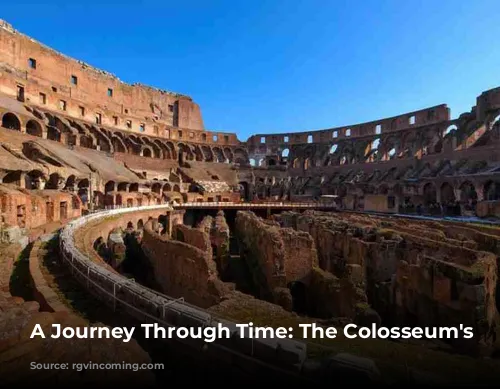The Colosseum, one of the most iconic structures in the world, holds within its ancient walls a captivating tale spanning centuries. Standing as a testament to Roman ingenuity and grandeur, the Colosseum’s story is as captivating as the gladiatorial contests it once hosted.

From Nero’s Dreams to Vespasian’s Vision
The Flavian Amphitheater, as it was originally known, was born from the ashes of Nero’s reign. Emperor Vespasian, seeking to restore Roman pride and counter the excesses of his predecessor, envisioned a monumental structure that would captivate the hearts of the people. In 72 AD, construction began on a site previously earmarked for Nero’s extravagant palace, the Domus Aurea. An artificial lake, intended for the Domus Aurea’s gardens, was drained and the ambitious project commenced. Sadly, Vespasian never lived to witness the completion of his grand vision, passing away before its completion.
A Celebration of Roman Might
Vespasian’s son, Titus, inherited the monumental task. In 80 AD, the Colosseum was inaugurated with a spectacular 100-day extravaganza. Naumachia, elaborate naval battles, were staged in the arena, made possible by an ingenious hydraulic system that flooded the arena with water. The festivities included a breathtaking display of animal hunts, with over 5000 creatures, including elephants, tigers, lions, hippos, panthers, and leopards, meeting their demise. The colosseum was a symbol of Roman power and a testament to their skill in engineering and spectacle.
A Monument in Peril
The Colosseum’s reign as a center of entertainment waned with the decline of the Roman Empire. Fires ravaged the structure, the first in 217 AD, followed by earthquakes and neglect. Ironically, this monument of Roman might was used as a source of building materials for churches and palaces across Rome and Italy. The once-grand arena became a quarry for marble, leaving the Colosseum a shadow of its former self.
A Rebirth and a Legacy
Despite its decline, the Colosseum’s significance remained. In 1744, Pope Benedict XIV halted the dismantling of the structure and declared it a sacred site. The Via Crucis, a solemn procession commemorating the Passion of Christ, began taking place within the arena annually, forever linking the Colosseum to Christianity.
The Colosseum’s Name: A Story of Dimensions
The name “Colosseum” first appeared in the Middle Ages, its origin shrouded in mystery. The most widely accepted theory suggests that the name arose due to its colossal dimensions, a testament to its size and grandeur. However, historians believe the “colossus” referred to a bronze statue of Nero, also colossal in size, which stood near the Domus Aurea and later relocated near the Colosseum.
A Timeless Symbol
Today, the Colosseum stands as a beacon of Rome’s glorious past. Its enduring presence serves as a reminder of the enduring power of human ingenuity and the remarkable legacy of ancient Rome.
Immerse Yourself in History
Experience the Colosseum’s grandeur firsthand. A guided tour will unlock the secrets hidden within its weathered walls and transport you back to a time of gladiators, emperors, and unparalleled spectacle. Discover the intricate engineering, the echoes of roaring crowds, and the stories woven into the very stones of the Colosseum. You will be left with a deep appreciation for the ingenuity and scale of ancient Roman construction, and the enduring legacy of the Colosseum.
